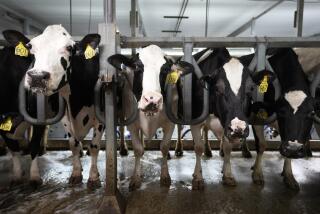Ranchers Switch to Raising Ostriches, Deer and Buffalo
- Share via
CHICAGO — The entrepreneurial spirit thrives in the U.S. livestock industry, with farmers and ranchers raising new and exotic livestock.
In Minnesota, domesticated deer are raised in a feedlot where cattle were once fed, and ostriches roam on a Texas ranch next to quarter horses and Thoroughbreds.
“The ostrich industry is over 100 years old, but not in the United States,” said Cooper Campbell, who started raising the birds on his Odessa, Tex., horse ranch three years ago.
Campbell expects in four to six years that there will be enough commercially raised ostriches to sustain markets for the meat, feathers and hide. Until then, the best market will be for breeding stock.
Newborn and young ostriches are expensive, costing $6,000 for a pair of 3-month-old chicks and escalating to $45,000 to $75,000 for a pair of 3-year-olds, Campbell said. However, prices should drop sharply once the industry matures and populations increase, he said.
A lot of economic hurdles face these fledgling livestock industries. Markets have to be developed for the meat, hides and breeding stock, and government standards for the meat must be established.
South Africa has a large commercial ostrich industry, and meat from the giant birds is marketed throughout Africa and Europe, said Campbell, who is a director of the American Ostrich Assn.
“It is a lean, red meat that more closely resembles beef than anything else,” he said. It is low in cholesterol and fat and can be processed into steaks and roasts.
Better-established in the United States is the market for ostrich hides, which are used for jackets, boots, belts and shoes.
In Minnesota, Dennis Gibson’s feedlots were empty for six years after he quit the cattle-feeding business in 1981. Then in 1987 he began commercially raising fallow deer, a domesticated Asian deer that is more disease resistant than the white tail and mule deer indigenous to the United States.
His herd of 250 deer is primarily for breeding purposes, and he regularly sells stags to other breeders.
“The deer are flighty but have no trouble adapting to the northern climate,” he said.
In five years, Gibson hopes that supplies will be sufficient to develop and sustain marketing channels for venison. Local cattle slaughter plants presently process the small amount of commercial venison on the market, he said.
The University of Minnesota extension service has supported deer farming with a symposium and educational material. Deer farming is successful in New Zealand, where there is a commercial herd of 700,000 head, and the industry is growing by 30% a year, the university said.
“In the U.S., there isn’t enough product (venison) available to establish a market, but we take 25% of the venison New Zealand exports,” said R.M. Jordan, a University of Minnesota extension animal scientist.
Venison contains 3% to 4% fat, compared to 35% for high-quality beef, Gibson said.
Still in its infancy is the commercial raising of native American bison, commonly known as the American buffalo. The University of Minnesota extension service reports about 90,000 head in the United States, of which 85% is under private ownership.
Demand for bison meat has increased in some areas because of its leanness and perceived lower cholesterol content.
More to Read
Sign up for Essential California
The most important California stories and recommendations in your inbox every morning.
You may occasionally receive promotional content from the Los Angeles Times.













